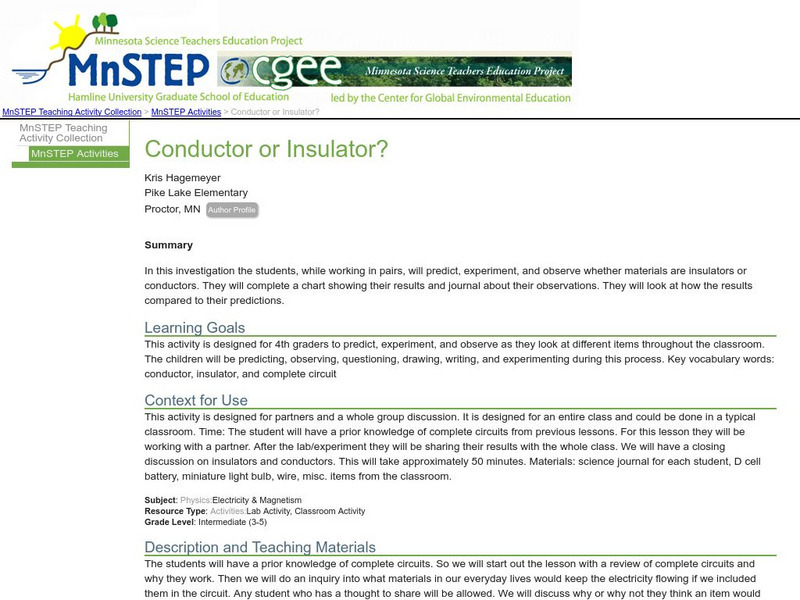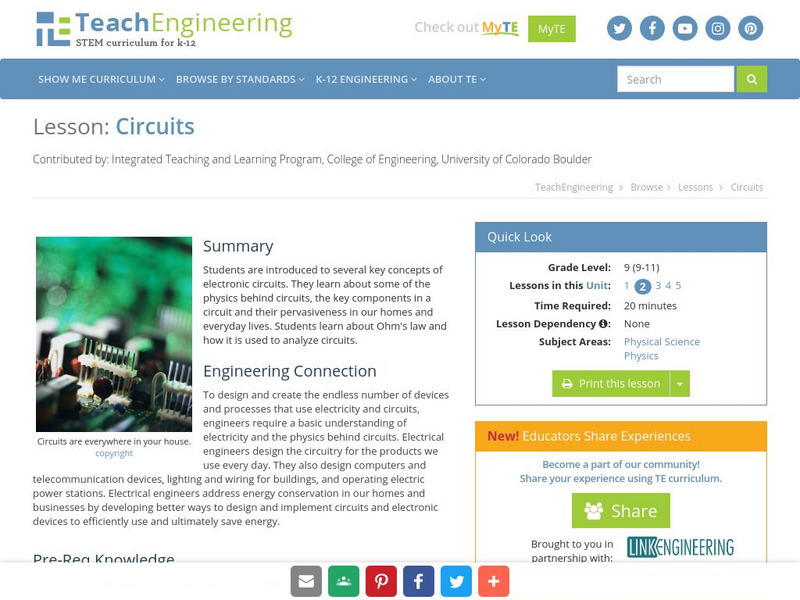Science Education Resource Center at Carleton College
Serc: Investigating Electricity: Building Circuits in Elementary Science Class
In this exploration activity, students compare the difference between series circuits and parallel circuits using wire, light bulbs, and D batteries.
Science and Mathematics Initiative for Learning Enhancement (SMILE)
Smile: Ohm's Law
For the teacher planning a lesson plan or for the student preparing for a project or presentation. This page describes a series of simple activities related to the voltage-current-resistance relationship.
Science and Mathematics Initiative for Learning Enhancement (SMILE)
Smile: Electrochemistry
A teacher lesson plan which could be easily converted into an idea for a student project or presentation. This page describes activities in which the interconversion of chemical and electrical energy are investigated. Complete activity...
Science Education Resource Center at Carleton College
Serc: Building an Electromagnet
Students will demonstrate how an electric current can make an iron object magnetic by building an electromagnet with a steel nail, insulated wire, a simple switch, a battery/cell, and small metal washers. Students predict the number of...
Science and Mathematics Initiative for Learning Enhancement (SMILE)
Smile: Simple Circuitry and Series Circuit
A teacher lesson plan which could be easily converted into an idea for a student project or presentation. This page describes an activity in which the basic nature of a circuit and the concepts of a series circuit are investigated....
Science Education Resource Center at Carleton College
Serc: Conductor or Insulator?
In this investigation the students predict, experiment, and observe whether materials are insulators or conductors.
Other
How to smile.org: Build a Wind Turbine
A step-by-step guide to build a wind turbine. Using their wind turbine, students test how much energy is created by using a variety of wind blades and wind speeds.
PBS
Pbs Teachers: Scientific American: Journey to Mars: Out of Thin Air
Discuss facts about Mars and investigate scientists' efforts to create fuel from materials found in space. Perform a simplified method of aqueous electrolysis to split water into its two chemical elements using electric current from a...
TeachEngineering
Teach Engineering: May the Magnetic Force Be With You
This lesson begins with a demonstration of the deflection of an electron beam. Students then review their knowledge of the cross product and the right hand rule with sample problems. After which, students study the magnetic force on a...
Science Education Resource Center at Carleton College
Serc: Electromagnetic Induction Demonstration
Students learn the relationship between the electric and magnetic fields. Specifically, they verify that a magnetic field is created in a current carrying coil of wire and a changing magnetic field can induce a current in another coil of...
TeachEngineering
Teach Engineering: Circuits
Students are introduced to several key concepts of electronic circuits. They learn about some of the physics behind circuits, the key components in a circuit and their pervasiveness in our homes and everyday lives. Students learn about...
Science Education Resource Center at Carleton College
Serc: Modeling Emf, Potential Difference, and Internal Resistance
Interactive lecture discusses internal resistance which provides help to students in developing an accurate model.
TryEngineering
Try Engineering: Series and Parallel Circuits
The core of this lesson is simple circuits and the differences between parallel and series circuit design. Students perform experiments to test the differences between the two circuit designs using low voltage light bulbs.
Science and Mathematics Initiative for Learning Enhancement (SMILE)
Smile: Electromagnets (Grades 3 and 4)
This lesson helps students to understand the difference between magenets and electromagnets. They will also create an electromagnet.
Other popular searches
- Current Electricity
- Static and Current Electricity
- Bill Nye Current Electricity
- Current Electricity Test
- Current Electricity Power
- Current Electricity Review
- Static or Current Electricity
- Statc or Current Electricity
- Static Electricity Current















